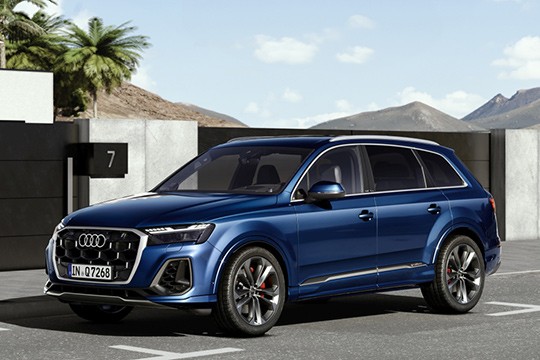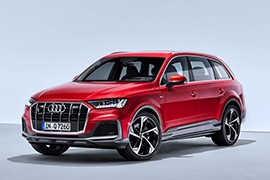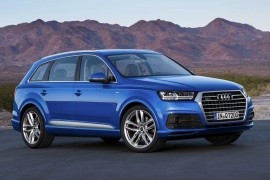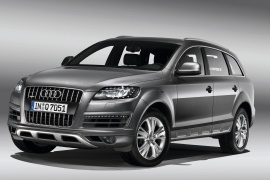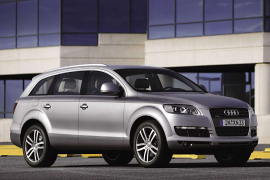AUDI Q7 Models/Series Timeline, Specifications & Photos
First production year: 2006
Engines: Gasoline, Diesel, Hybrid gasoline
Body style: SUV (Sports Utility Vehicle)
Audi launched the second facelift for its flagship SUV Q7 in January 2024, thus extending the life of the car’s second generation on the market.
The German automaker unveiled the second generation of the Q7 in 2015, at a time when customers were craving SUVs and other seven-seat vehicles. The Q7 became a sales hit for the four-ring badged brand with its luxurious cabins and powerful engines. Then, four years later, in 2019, the automaker refreshed the vehicle like it was business as usual. Customers were ready for a new model in 2023, but the automaker introduced a second facelift in early 2024 instead of a new model. Audi considered that it was not ready yet for a third generation of this moniker and just improved the crossover on the outside, inside, and under its skin.
Sporting an improved front fascia, the second facelift of the Q7 had a demanding look over the road. Its new LED headlights sported upper daytime running lights instead of lower ones, like the 2019 model year. As an option, customers could get HD Matrix LED headlights with laser lights for improved nighttime driving. Another significant change for the car’s front was the massive single-frame grille surrounded by a chromed trim, which was slightly modified and adorned by a new mesh with a big hexagonal pattern. Furthermore, Audi installed new side scoops on the lower side of the bumper, resembling those installed on the Q4 e-tron.
While the front fascia was the one that received the most attention from Audi’s styling department, the 2024 Q7 had some slightly modified lines on the car’s profile. It still featured a chromed trim around the window line, but it was slimmer than its predecessor. In addition, the lower side of the car sported aerodynamically-profiled sills, which reduced ground effect. Finally, out back, the automaker offered OLED taillights for the first time in the Q7 lineup, complementing the regular LED lights that were fitted as standard.
Inside the cabin, customers found comfortable bucket seats at the front with high-bolstered areas. As an option, these could be upgraded to leather upholstery and various heating, cooling, and massaging functions. Between the front occupants, the Q7 had a wide center console that housed the gear selector and two cup holders. The touchscreen for the HVAC system was at the base of the center stack, where a touchscreen for Audi’s MIB3 infotainment system was located. For the first time in the Q7, Audi installed third-party provider apps, such as Spotify or Amazon Music, which allowed passengers to listen to their tunes. A seven-seat version with power-operated rearmost seats was available for the entire range.
The 2024 Q7 came prepared and qualified to tow up to 3.5 tons behind, regardless of the version. For regular driving modes, cylinder deactivation was available for selected versions and driving behaviors. Audi tried to lower its flagship SUV’s fuel consumption but without compromising performance.
The biggest Audi SUV has received a facelift at the end of 2019 and some improvements were long-awaited by the four-silver-rings fans. At first look, it finally received the octagon front-grill, which is already present on the Q8 and on most of the other Audi modern models. On the front bumper there is a new blade, which accentuates the sporty look of the massive SUV.
The 19” wheels are standard on the Q7 or 20” for the most powerful version, SQ7. The engines received a well awaited mild-hybrid version. This means that a new starter-generator driven by belt will help lower the fuel consumption with 0.7 l/100 km. Due to this new 48V mild-hybrid system, the start-stop function can work bellow 22 kph (13.6 mph). The most powerful version is the SQ7, which offers 435 HP. There is also a gasoline-hybrid version with a 3.0-liter V6 engine under the hood. This one has 340 HP and the electric system promises to offer a 43 km (26.7 miles) all-electric range.
Inside the cabin, the occupants should expect nothing than luxury and hi-tech. The new infotainment system allows multiple phone connections, Apple CarPlay and Android Auto. Of course, there are no dials on the instrument cluster. Only a big 12.3” LCD display, called Audi Virtual Cockpit and an optional head-up display.
The second generation of the largest Audi SUV was launched in 2015 and it had more power, less weight and a lot of technology inside.
The Q7 has received a new shape and it looked more like an expanded station wagon rather than an SUV. The big headlights can be equipped with full LEDs for better visibility on the road. The windshield has been angled a little bit more for a better aerodynamic shape and the rear looks like a regular Audi Avant.
Inside, there are a lot of improvements, starting with the optional Audi Virtual Cockpit display that replaced the regular instrument cluster and a new ventilation system with a large air-vent across the dashboard. The pop-up screen for the infotainment system is a nice way to hide the tablet, which can be accessed via a touch-pad in front of the gear-lever. There is room for up to seven passengers, even if the last row is not quite spacious for people over 1.80 m (6 ft). The trunk is big and if second and third rows are folded, there is room for everything. It can be used for a mobile tent too.
Under the hood, there are a lot of engine choices. The European loved the 3.0 TDI version, which was a very good option in terms of price vs. performance and fuel-efficiency. The standard transmission is an 8-speed automatic gearbox. After all, the car's platform was the Volkswagen MLBevo, which can be found in the Porsche Cayenne, Bentley Bentayga, and Lamborghini Urus.
The first SUV released by Audi in 2006 was redesigned for 2009 and fixed most of the downsides found for its predecessor.
The Q7 was a combination of luxury, practicality and a good choice for larger families in need for a 3rd row of seats.
The base model 3.6 could accommodate up to 5 passengers. It was equipped with standard 18-inch wheels, power front seats, a good quality leather upholstery and a dual-zone automatic climate control.
The version offering room for 7 passengers came with 3 variants: Premium, Premium Plus and Prestige. The first trim level added a power liftgate to ease loading, a Bluetooth connectivity and other great features, while, the top of the range, the Prestige added xenon headlights, a blind spot monitor and voice recognition for both audio and navigation.
The engine range was varied, with 3 options to choose from: a 3.6-liter V6 that produced 280 hp, a 4.2-liter V8 with 350 hp and the new 3.-liter V6 with 225 and the highest torque offered across the range, 406 lb.-ft.
Safety wise, the Q7 offered ABS, a stability control system with hill-descent control, traction control, side and front airbags and an optional lane assist system.
The interior of the Q7 was luxurious with high quality materials used throughout the cabin.
The first generation of the Audi Q7 was launched in September 2005 as a 2006 model. It came late to the big SUV party, but it recovered fast.
While the first generation of the Mercedes-Benz ML was revealed in 1997 and the first BMW X5 appeared in 1999, the Q7 waited for a decade after the three-pointed-star SUV to show on the market. And they had the time to do it right.
The Q7 impressed with its design, reflected in the broad curve of the roofline and a high body surface in relation to the flat window area. It had a dynamic sweep of the front section and a sloped to the rear roofline. For the inside, the Q7 was available with no less than 28 seating configurations possible in the Q7 including a 7-seat option.
The interior comfort featured high-quality materials and great attention. It featured a standard Multi Media Interface for the infotainment system and, as an option, an Audi Music Interface allowed connectivity with an iPod or other MP3 players. At that time, it didn't have a USB port to directly stream the music from it.
The technical platform was tested before on the Volkswagen Touareg and the Porsche Cayenne. On the Q7 though it had some special modifications to allow bigger and more powerful engines. For the transmission, it featured a standard 6-speed automatic and an all-wheel-drive
quattro system with a Torsen center differential that sent the torque into a 40:60 percent, biased to the rear as in the RS4 model.
